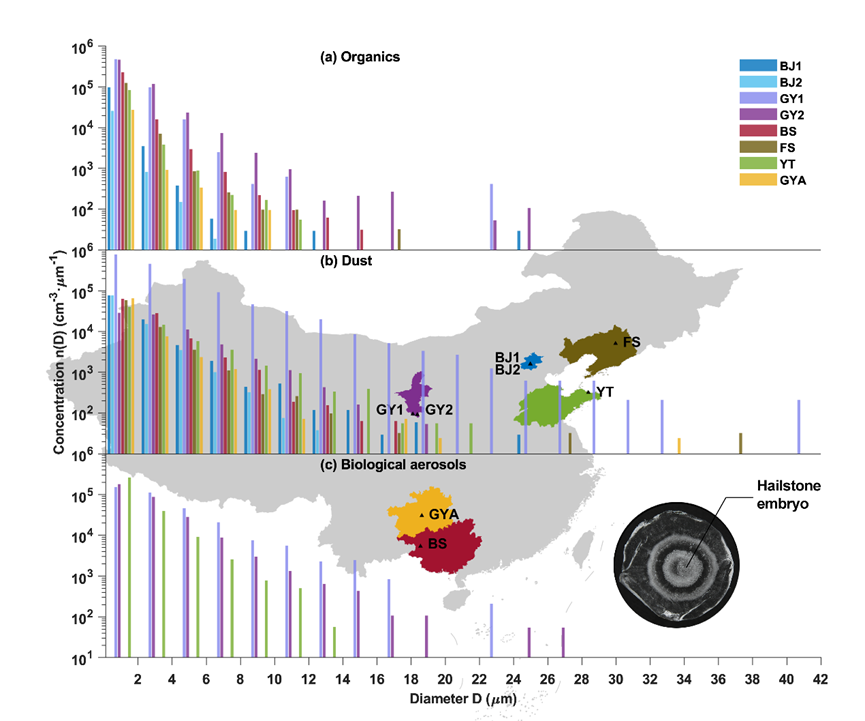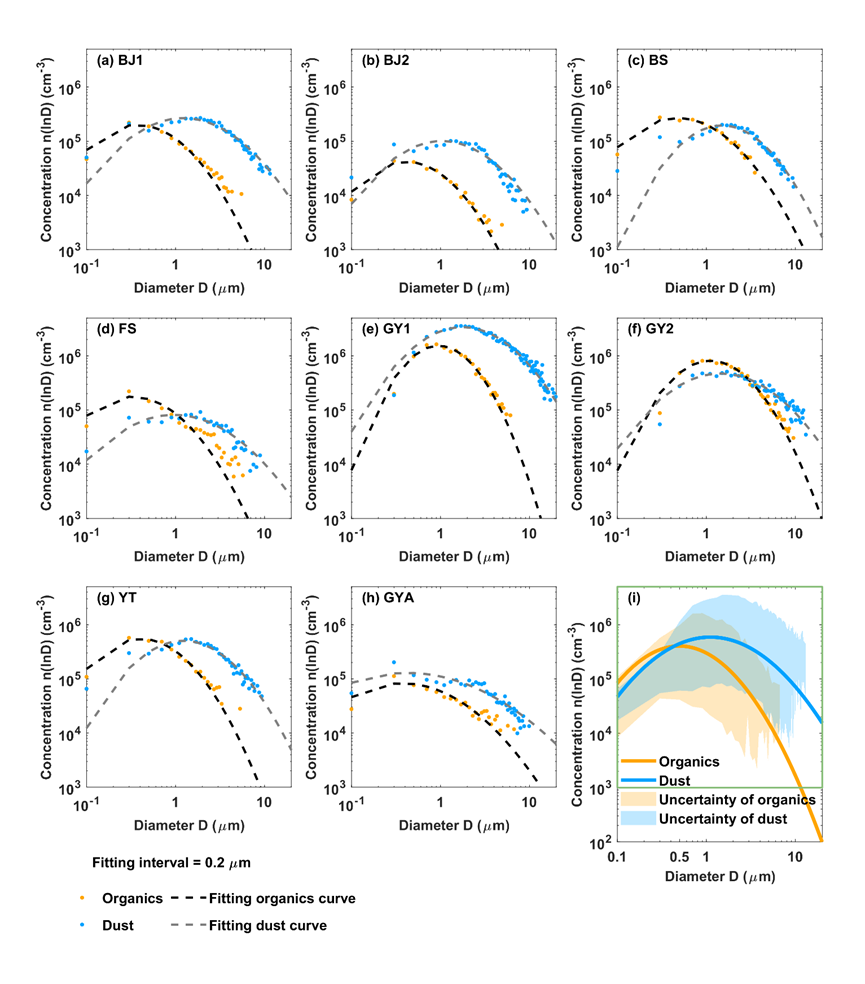冰雹内不可溶颗粒物的观测
张庆红
大气中的不可溶颗粒物作为主要的非均相冰核,可以改变云水相态,进而影响全球天气和气候的变化。由于缺乏对云中冰核的完整微物理观测,大部分天气和气候数值模式中的微物理参数方案使用环境温度和过饱和比计算冰晶的数量浓度,忽略了冰核的物种和尺寸等物理化学属性,这一描述缺陷导致数值模式估计冰晶数量时存在偏差。
冰雹是一种来自深对流云的固态降水现象,冰雹雹粒在深对流云中的增长过程“记录”了强风暴对流云中的大气气溶胶信息。因此,分析冰雹雹粒中不可溶颗粒物的数浓度、物种及尺寸,可以为深对流云中的冰核观测提供一种新的思路。本课题组利用扫描电镜和能量色散x射线能谱,结合机器学习方法,分析了2016至2021年在中国境内不同地区收集的12颗冰雹内不可溶颗粒物的成分以及尺寸谱分布。结果显示,冰雹内不可溶颗粒物的数浓度、物种和尺寸呈现了多样性。不同冰雹雹粒中的不可溶颗粒物数浓度相差1-2个数量级,单颗冰雹不同冰层间的不可溶颗粒物尺寸谱分布变化远低于不同冰雹雹胚内不可溶颗粒物尺寸谱分布的差异(图1)。这是因为强对流风暴中的强上升气流将局地地表或边界层的不可溶颗粒物带入云内,雹胚形成需要不可溶颗粒物作为启动冰核形成冰晶,而雹胚层外的生长依赖于过冷水滴的吸积,但是冰雹雹胚以及外部冰层中的不可溶颗粒物均记录了局地气溶胶的特征。
本研究是首个同时观测冰雹雹粒中不可溶颗粒物的数浓度、物种和尺寸的工作,我们的发现强调了在大气成冰过程的模拟中应该不仅考虑环境的物理特征,也需要考虑不可溶颗粒物的物理化学特征。本研究还拟合出了冰雹雹胚中有机物和沙尘的经典对数正态分布模型(图2),尽管存在不确定性,但可以应用于未来天气和气候模式中的微物理参数化方案。

图1 (a)有机物,(b)沙尘,(c)生物蛋白气溶胶在冰雹雹胚中的尺寸谱分布。
Fig. 1. Size distribution of (a) organics, (b) dust and (c) bioprotein aerosols in hailstone embryos.

图2冰雹有机物和沙尘尺寸的对数正态分布。(a)-(h)各个冰雹的对数正态分布拟合。(i)有机物和沙尘的经典模态。
Fig. 2 Lognormal distribution of organics and dust size in hailstones. (a)-(h) Fitting curves of each hailstone. (i) Classical modes of organics and dust.
Analysis of insoluble particles in hailstones
Insoluble particles, acting as the main heterogeneous ice-nucleating particles in the atmosphere, may alter the cloud water phase and further affect weather and climate. Due to the lack of comprehensive microphysical observations of ice-nucleating particles in clouds, temperature and vapor supersaturation are used to calculate the number concentration of ice crystal particles in the microphysical parameterization, instead of considering the physical and chemical properties such as species and size of ice-nucleating particles in weather and climate models. The lack of description of ice-nucleating particles in models can lead to biased estimation of ice crystal quantities.
Hail is a form of solid precipitation in deep convective clouds. Hailstones can record atmospheric aerosol information during their growth within deep convective clouds. Therefore, analyzing the number concentration, species, and size of insoluble particles in hailstones provides a new perspective for observing ice-nucleating particles in deep convective clouds. We analyzed the species and size distribution of insoluble particles in 12 hailstones collected from different regions in China between 2016 and 2021, using a combination of scanning electron microscopy and energy dispersive X-ray spectroscopy integrated with a machine learning approach. The results revealed a variation in the number concentration, type, and size of insoluble particles in hailstones. The difference in number concentration of insoluble particles between hailstones spans 1 to 2 orders of magnitude. The variability in the size distribution of insoluble particles among shells within a single hailstone was considerably less than the size distribution of insoluble particles among different hailstone embryos (Figure 1). This is because the updraft of a severe storm carries insoluble particles from the surface or boundary layer of the atmosphere into the cloud. Insoluble particles in both hailstone embryos and residual shells all record local aerosol information, although hailstone embryos require insoluble particles as initial ice-nucleating particles to form ice crystals, and hailstone growth depends on the accretion of supercooled droplets after the embryo stage.
This study is the first to simultaneously observe the number concentration, species, and size of insoluble particles in hailstones. Our results highlight the need to consider atmospheric chemistry in the simulation of the ice freezing process, rather than the physical character of the surrounding atmosphere. Furthermore, we fit the classical size distribution of organic matter and dust to log normal distributions (Figure 2), which could potentially be adapted in future weather and climate models, despite the existence of uncertainties.
Reference
Zhang, H., Lin, X., Zhang, Q., Bi, K., Ng, C.-P., Ren, Y., Xue, H., Chen, L., and Chang, Z.: Analysis of insoluble particles in hailstones in China, Atmos. Chem. Phys., 23, 13957–13971, https://doi.org/10.5194/acp-23-13957-2023, 2023.
